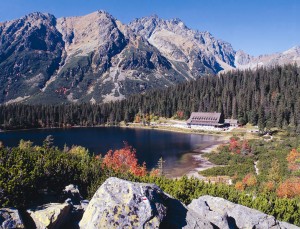

Slovak Republic
 Slovak Republic is a small country, but its striking landscape varies from lowlands to mountain ranges.The country is famous throughout Europe for the magnificent Tatras mountains, seemingly magical ancient towns, romantic knights’ castles, and beautiful ski resorts. Mountains, lowlands, canyons, lakes, caves, forests and grasslands give Slovak Republic a unique natural beauty throughout the year. Nearly half the country is covered by the Carpathian arch, the Small Carpathians, the White Carpathians, the High Tatras, the Low Tatras and the Slovak Ore Mountains.
Slovak Republic is a small country, but its striking landscape varies from lowlands to mountain ranges.The country is famous throughout Europe for the magnificent Tatras mountains, seemingly magical ancient towns, romantic knights’ castles, and beautiful ski resorts. Mountains, lowlands, canyons, lakes, caves, forests and grasslands give Slovak Republic a unique natural beauty throughout the year. Nearly half the country is covered by the Carpathian arch, the Small Carpathians, the White Carpathians, the High Tatras, the Low Tatras and the Slovak Ore Mountains.
The mountains, forests and lakes fascinate visitors with their beauty and make Slovakia an ideal country for relaxation and summer and winter sports. The longest cycle route in Europe passes through this country. In Slovak Republic, there are five national parks and 16 protected natural areas. These sites are virtually untouched by man. The Low Tatras National Park covers the second highest mountain range of the Western Carpaths. Within the boundaries of the national park there are several ski resorts. There are popular winter sports centres in the mountainous areas, of which the Tatras are the best.
The most visited Slovak ski resorts are High (2655m) and Low (2045m) Tatras, Mala and Velka Fatra (1709m) and Slovak Ore mountains (1025m). Slovakia is a leading tourist destination in Europe because of its underworld and mineral water springs. This “Slovak gold” is used in 22 Spas. The most famous are Piestany, Trencianske Teplice, Sliach, and Bardejovske Kupele. There are thermal pools based on the thermal springs, where the water temperature is around +35° С all year round. The mountain climatic resorts on the slopes of the High tatras – Strebske Pleso, Smokovtsy, Tatranska-lomnica, Polanka and others – are not inferior in treatment efficiency to those of Swiss resorts.
In Slovak Republic you can find monuments from all historic periods. Nitra – the center of the principality of the same name – is an old Slavic fortified settlement. City Attractions like the Castle complex, the monastery, the Franciscan Church, the Palace (1779), Colonna (1739) and the Abbey Library are situated in the Old Seminary of the XVIII century. Long mining traditions of Banska Styavnitsy persisted through the centuries. In the city centre, you can find the burgher houses in the Renaissance style. Among other attractions you can see the Old Castle (1548), the building of the Mountain and Forest Academy. Given the importance of Banska Styavnitsy and its monuments, the mining town was included in the List of World Cultural Heritage by UNESCO in 1993. Mining and coinage played an important role in the history of Kremnica. Historical buildings include the City Castle (14th-19th centuries), with an extensive complex of Gothic and Renaissance buildings, and a small Miners’ Gallery (18th-19 centuries). Museums of coins and medals are worth visiting too. Located in central Slovakia, Banska Bystrica was first mentioned in 1255. Deposits of silver ore and copper provided the prosperity of the city as a mining centre. Its face is dominated by several Gothic and Renaissance buildings, including two Gothic churches, a town hall and a municipal building with turrets and Barbican. The Spis region has numerous historical medieval towns, villages and other settlements. Here, in Levoca, is the world’s highest Gothic altar. In the city of Kezmarok one should visit the 15th century Gothic castle chapel with its 17th century astrological clock. All over the city there are ruins of the city walls and castles dating back to the 14th and 16th centuries.
The centre of the medieval city of Bardejov is an oblong square, surrounded by beautiful Gothic burgher houses made during the Renaissance. In Slovak Republic you can see, taste, and hear the heart of the country in the heart of Europe.


